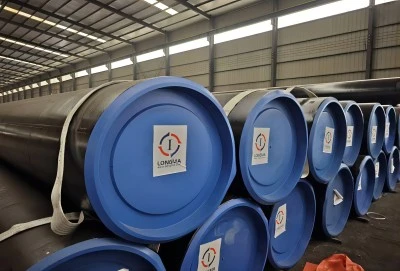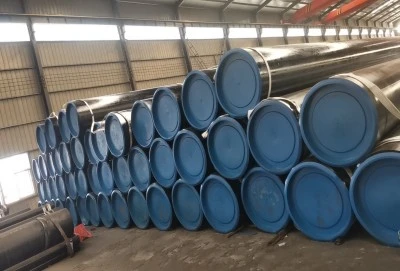In the world of steel pipe manufacturing, two prominent types stand out: long seam welded pipes and spiral welded pipes. Both play crucial roles in various industries, from oil and gas transportation to construction and infrastructure development. However, they differ significantly in their structure, manufacturing processes, and ideal applications. This article will explore these differences in detail, helping you understand which type might be best suited for your specific needs.
|
|
|
What are the structural differences between long seam welded pipes and spiral welded pipes?
The most apparent difference between long seam welded pipes and spiral welded pipes lies in their structural composition, particularly in the orientation of their welding seams.
Long seam welded pipes, also known as longitudinal seam welded pipes or LSAW pipes, feature a single weld seam that runs parallel to the length of the pipe. This seam is created by bending a flat steel plate into a cylindrical shape and welding the edges together. The result is a pipe with a straight seam running from one end to the other.
On the other hand, spiral welded pipes, also called helical welded pipes or HSAW pipes, have a continuous helical weld that spirals around the pipe's circumference. This unique structure is achieved by coiling a steel strip at an angle and welding the edges as they meet to form the pipe.
The structural differences between these two types of pipes lead to varying characteristics:
- Seam Length: Long seam welded pipes have a single seam equal to the pipe's length, while spiral welded pipes have a much longer seam due to its helical nature.
- Stress Distribution: Spiral welded pipes tend to distribute stress more evenly along the pipe due to the helical seam, potentially offering better resistance to internal pressure.
- Diameter Range: Long seam pipes are typically available in larger diameters compared to spiral welded pipes.
- Wall Thickness: Long seam pipes can generally accommodate thicker walls than spiral welded pipes.
These structural differences play a significant role in determining the suitability of each pipe type for various applications.
How do manufacturing processes vary between long seam and spiral welded pipes?
The manufacturing processes for long seam welded pipes and spiral welded pipes differ significantly, each with its own set of advantages and challenges.
Long seam welded pipe production typically follows these steps:
- Steel Plate Preparation: High-quality steel plates are cut to the required dimensions.
- Edge Preparation: The edges of the plate are beveled to ensure proper weld penetration.
- Forming: The plate is bent into a cylindrical shape using powerful rollers.
- Tack Welding: The edges are temporarily held together with tack welds.
- Welding: The seam is welded using submerged arc welding (SAW) or other high-quality welding methods.
- Heat Treatment: The welded pipe undergoes heat treatment to relieve internal stresses.
- Testing and Inspection: The pipe is subjected to various tests to ensure quality and integrity.
Spiral welded pipe manufacturing, on the other hand, involves these steps:
- Steel Coil Preparation: A continuous steel strip is fed into the production line.
- Forming: The strip is gradually shaped into a spiral form.
- Welding: As the edges meet, they are welded continuously to form the pipe.
- Cutting: The spiral-formed pipe is cut to the desired length.
- Heat Treatment: The pipe may undergo heat treatment to relieve stresses.
- Testing and Inspection: Quality control measures are implemented to ensure pipe integrity.
The key differences in these manufacturing processes include:
- Raw Material: Steel plates, while spiral welded pipes use steel strips or coils.
- Welding Process: Typically involves a single, long weld, while spiral welded pipes require continuous welding as the pipe is formed.
- Production Speed: Spiral welded pipe production can be faster and more continuous, especially for smaller diameters.
- Size Limitations: Generally produced in larger diameters and thicker walls compared to spiral welded pipes.
These manufacturing differences contribute to the unique characteristics and applications of each pipe type.
Which applications are best suited for long seam welded pipes versus spiral welded pipes?
The choice between long seam welded pipes and spiral welded pipes often depends on the specific requirements of the application. Each type has its strengths, making it more suitable for certain uses.
Long seam welded pipes are typically preferred for:
- High-Pressure Applications: Due to their ability to withstand higher internal pressures, long seam pipes are often used in oil and gas transmission lines, especially for offshore pipelines.
- Large Diameter Requirements: When very large diameters are needed (over 100 inches), long seam pipes are usually the go-to choice.
- Thick-Walled Pipes: Applications requiring thick-walled pipes often utilize long seam pipes due to their manufacturing process allowing for greater wall thickness.
- Critical Infrastructure: In projects where the highest level of structural integrity is paramount, such as in nuclear power plants or high-pressure chemical processing facilities, long seam welded pipes are often preferred.
Spiral welded pipes are typically better suited for:
- Water Transmission: Many municipal water systems use spiral welded pipes due to their cost-effectiveness and suitability for lower pressure applications.
- Piling and Foundation Work: The continuous spiral seam provides good axial strength, making these pipes suitable for use as piles in construction projects.
- Ventilation Systems: In large industrial settings, spiral welded pipes are often used for ventilation ducts due to their ability to be produced in long, continuous lengths.
- Moderate Pressure Oil and Gas Lines: While not suitable for the highest pressure applications, spiral welded pipes can be used effectively in many oil and gas transmission scenarios.
It's important to note that advancements in manufacturing technologies have expanded the capabilities of both pipe types. For instance, high-grade spiral welded pipes are now being used in some high-pressure applications traditionally dominated by long seam welded pipes.
When choosing between long seam welded pipes and spiral welded pipes, factors to consider include:
- Required pressure rating
- Desired pipe diameter and wall thickness
- Project budget (spiral welded pipes are often more cost-effective)
- Available transportation and installation equipment
- Local manufacturing capabilities
- Specific industry standards and regulations
By carefully evaluating these factors, project engineers can select the most appropriate pipe type for their specific application, ensuring optimal performance and cost-effectiveness.
About LONGMA GROUP
Understanding the differences between long seam welded pipes and spiral welded pipes is crucial for making informed decisions in pipeline projects. While long seam welded pipes excel in high-pressure and large-diameter applications, spiral welded pipes offer cost-effectiveness and efficiency in many scenarios.
At LONGMA GROUP, we specialize in producing high-quality long seam welded pipes that meet the most demanding industry standards. Our pipes are engineered to withstand high pressures and provide reliable performance in critical applications. Whether you're planning an oil and gas transmission project, constructing a water supply system, or need pipes for any other industrial application, we're here to help.
Don't hesitate to reach out to our team of experts for guidance on selecting the right pipe for your project. Contact us at info@longma-group.com to discuss your specific needs and how our long seam welded pipes can contribute to the success of your project.














